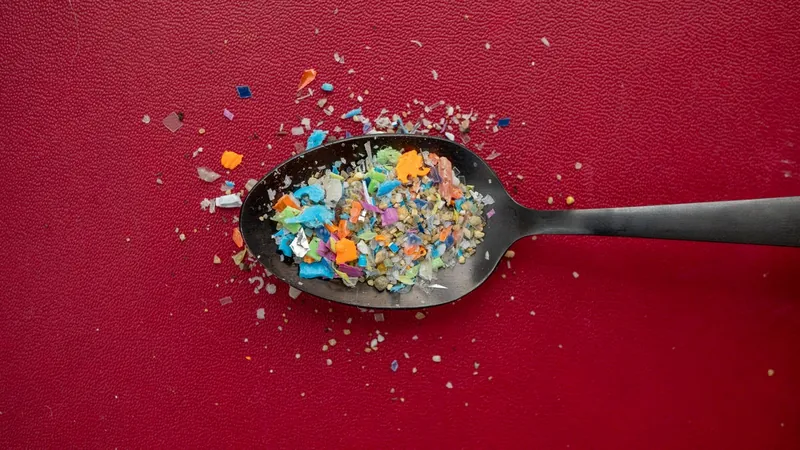
7 Kitchen Items Harboring Microplastics You Must Ditch Now!
2025-09-15
Author: Wei
Imagine finding out that with every bite you take, you're also consuming tiny particles of plastic! Yes, microplastics are now a shocking reality infiltrating our food, water, and even the very air we breathe. Studies are revealing alarming potential health risks linked to these invisible invaders that could pose serious long-term risks.
A recent study from February 2025 uncovered a chilling fact: microplastics don't just pass through our systems—they can accumulate in our bodies, raising crucial concerns about their connection to health issues like heart disease and even cancer.
Why Microplastics Are a Serious Concern
Microplastics are everywhere, and roughly 22 million tiny particles are inhaled by each person every year. They can sneak into our bodies from three main entry points: inhalation, ingestion, and contact with our skin.
The negative effects can be severe, ranging from inflammation and tissue damage to increased risks of heart attacks and strokes. Animal studies even show they can cause extensive DNA damage and stress in marine life, making the situation all the more concerning.
Where You’ll Find Microplastics in Your Kitchen
Surprisingly, much of this plastic menace finds its way into our homes through everyday kitchen items. Here are seven common culprits you should consider dumping immediately:
1. Nonstick Cookware
Your favorite frying pan may be a hidden source of microplastics! New research indicates that nonstick cookware can leach these particles into your food, especially when scratched or damaged.
2. Plastic Food Containers
The convenience of takeout comes with a price. Many plastic containers used for food storage can release microplastics when heated or washed.
3. Plastic Utensils
Be careful with those plastic forks! Studies show that these utensils can transfer microplastics into your meals, especially when served with hot foods.
4. Tea Bags
Surprisingly, your morning tea might not be as wholesome as you think. Polypropylene in tea bags can leach billions of microplastic particles when steeped in hot water.
5. Certain Spices
Your favorite spices, particularly those in plastic packaging, may be contaminated with microplastics—an unsettling reality for many home cooks.
6. Plastic Straws
Plastic straws aren’t only a menace to marine life—they also release harmful microplastics that can enter your body when ingested.
7. Canned Food Linings
Canned goods might save you time, but the linings often contain microplastics. Even alternatives to BPA are not proven safe!
Smart Swaps for a Healthier Kitchen
Fortunately, making healthier choices is easier than you think. Check out these alternatives to significantly reduce your microplastic intake:
- Switch to Wooden or Stainless Steel Utensils
Replace plastic utensils with safe, eco-friendly options!
- Use Glass or Stainless Steel Containers
Opt for non-plastic food storage to steer clear of contamination.
- Brew Loose Leaf Tea
Say goodbye to tea bags and embrace loose leaf tea using a stainless steel infuser.
- Choose Bulk or Glass-Spiced Containers
By avoiding plastic packaging, you keep harmful particles out of your meals.
- Go for Reusable Metal or Bamboo Straws
Ditch disposable plastic straws in favor of sustainable alternatives.
The Bottom Line
Microplastics are lurking in your kitchen cupboards, and it's time to take action. The health risks they pose are too significant to ignore. Evaluate your kitchen items and consider these healthy swaps to protect your body and the environment from their harmful influence.
 Brasil (PT)
Brasil (PT)
 Canada (EN)
Canada (EN)
 Chile (ES)
Chile (ES)
 Česko (CS)
Česko (CS)
 대한민국 (KO)
대한민국 (KO)
 España (ES)
España (ES)
 France (FR)
France (FR)
 Hong Kong (EN)
Hong Kong (EN)
 Italia (IT)
Italia (IT)
 日本 (JA)
日本 (JA)
 Magyarország (HU)
Magyarország (HU)
 Norge (NO)
Norge (NO)
 Polska (PL)
Polska (PL)
 Schweiz (DE)
Schweiz (DE)
 Singapore (EN)
Singapore (EN)
 Sverige (SV)
Sverige (SV)
 Suomi (FI)
Suomi (FI)
 Türkiye (TR)
Türkiye (TR)
 الإمارات العربية المتحدة (AR)
الإمارات العربية المتحدة (AR)